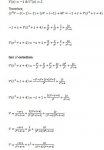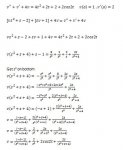You are using an out of date browser. It may not display this or other websites correctly.
You should upgrade or use an alternative browser.
You should upgrade or use an alternative browser.
Second order differential (laplace)
- Thread starter Bibbster
- Start date
D
Deleted member 4993
Guest
Now look up the inverse transforms from a table.Hey guys , needing help with this question below. Confusing myself and don't know where I'm going wrong or what to do next any help would be greatAlso v(o)=-1 not 1 as stated in picture
View attachment 3382
Now look up the inverse transforms from a table.
I have, to no avail. Hence why I came here for a helping hand.
D
Deleted member 4993
Guest
I have, to no avail. Hence why I came here for a helping hand.
Are you serious?
You could not find Inverse transform of \(\displaystyle \dfrac{1}{s^2}\)? (which is simply 't')!!
You actually used the transform (t → \(\displaystyle \dfrac{1}{s^2}\)) above!!!
Last edited by a moderator:
Are you serious?
You could not find Inverse transform of \(\displaystyle \dfrac{1}{s^2}\)? (which is simply 't')!!
Well yeah that one I could but the others I can't , no need to be such a smart ***. Was just curious if I was right so far and how to continue
D
Deleted member 4993
Guest
Well yeah that one I could but the others I can't , no need to be such a smart ***. Was just curious if I was right so far and how to continue
Your comment "I have, to no avail. Hence why I came here for a helping hand." shows your sincerity in solving this problem with honest effort!
All the expressions you wrote can be converted to standard expressions whose transfers are in the table.
From 3rd. to last line - to 2nd to last line, you concluded (as far as I can see),
\(\displaystyle \displaystyle \dfrac{2s}{(s^2+4)(s^2+s+4)} \ = \ \dfrac{2s}{(s^2+4)} + \dfrac{2s}{(s^2+s+4)} \)
That is incorrect.
HallsofIvy
Elite Member
- Joined
- Jan 27, 2012
- Messages
- 7,760
Gosh, I dislike the "Laplace transform" method! This problem can be done is just a few minutes using the "characteristic equation" and "undetermined coefficients" methods. Can anyone give an example of a differential equation that cannot be solve more easily with direct methods than with the Laplace tranform?
D
Deleted member 4993
Guest
Gosh, I dislike the "Laplace transform" method! This problem can be done is just a few minutes using the "characteristic equation" and "undetermined coefficients" methods. Can anyone give an example of a differential equation that cannot be solve more easily with direct methods than with the Laplace tranform?
As the order of the linear ODE goes up beyond 3, Laplace Transform becomes the favorite choice! Of course - the reason being that the ODE is converted to an algebraic equation - which is "easier" to solve.
Your comment "I have, to no avail. Hence why I came here for a helping hand." shows your sincerity in solving this problem with honest effort!
All the expressions you wrote can be converted to standard expressions whose transfers are in the table.
From 3rd. to last line - to 2nd to last line, you concluded (as far as I can see),
\(\displaystyle \displaystyle \dfrac{2s}{(s^2+4)(s^2+s+4)} \ = \ \dfrac{2s}{(s^2+4)} + \dfrac{2s}{(s^2+s+4)} \)
That is incorrect.
Taking into account what you have said , i now have this below. Still very daunting to work out however just an idea , i assume i can have :
\(\displaystyle \displaystyle \ \dfrac{-s}{(s^2+s+4)} + \dfrac{1}{(s^2+s+4)} \) which would then leave me to find possible solutions for \(\displaystyle \displaystyle [s^2+s+4] \) with one being \(\displaystyle \displaystyle =(s+0.5)^2+15/4 \). Then after that (if correct) i'm once again confused

Last edited:
D
Deleted member 4993
Guest
.Taking into account what you have said , i now have this below. Still very daunting to work out however just an idea , i assume i can have :
\(\displaystyle \displaystyle \ \dfrac{-s}{(s^2+s+4)} + \dfrac{1}{(s^2+s+4)} \) which would then leave me to find possible solutions for \(\displaystyle \displaystyle [s^2+s+4] \) with one being \(\displaystyle \displaystyle =(s+0.5)^2+15/4 \). Then after that (if correct) i'm once again confused.
Now use method of partial fractions to break-up\(\displaystyle \dfrac{2s}{(s^2+4)(s^2+s+4)}\)
View attachment 3386
Last edited by a moderator:
From the \(\displaystyle \displaystyle \ \dfrac{-s+1}{(s^2+s+4)} \) that i have , i assumed it could be split up ?
D
Deleted member 4993
Guest
From the \(\displaystyle \displaystyle \ \dfrac{-s+1}{(s^2+s+4)} \) that i have , i assumed it could be split up ?
yes.... Now use method of partial fractions to break-up\(\displaystyle \dfrac{2s}{(s^2+4)(s^2+s+4)}\)
yes.... Now use method of partial fractions to break-up\(\displaystyle \dfrac{2s}{(s^2+4)(s^2+s+4)}\)
Done that , now have \(\displaystyle \dfrac{2}{(s^2+4)}\)\(\displaystyle -\)\(\displaystyle \dfrac{2}{(s^2+s+4)}\) with \(\displaystyle \dfrac{2}{(s^2+4)}\) becoming \(\displaystyle Sin2t\) and \(\displaystyle \dfrac{2}{(s^2+s+4)}\) becoming \(\displaystyle \dfrac{2}{(s^2+0.5)^2+15/4}\) however im struggling to tackle this one , if you could point me in right direction that'd be great
D
Deleted member 4993
Guest
Done that , now have \(\displaystyle \dfrac{2}{(s^2+4)}\)\(\displaystyle -\)\(\displaystyle \dfrac{2}{(s^2+s+4)}\) with \(\displaystyle \dfrac{2}{(s^2+4)}\) becoming \(\displaystyle Sin2t\) and \(\displaystyle \dfrac{2}{(s^2+s+4)}\) becoming \(\displaystyle \dfrac{2}{(s^2+0.5)^2+15/4}\) however im struggling to tackle this one , if you could point me in right direction that'd be great
Again look at the Laplace transform table carefully!
\(\displaystyle \dfrac{2}{(s^2+0.5)^2+15/4}\) this will be transformed to A * e-at * sin(wt)
HallsofIvy
Elite Member
- Joined
- Jan 27, 2012
- Messages
- 7,760
If the order is greater than 3, the characteristic equation is of degree higher than 3 so, of course, difficult to solve. But to use the Laplace transform you will need to factor the denominator of the fraction you get as the Laplace transform of the function. And that will be a polynomial of the same degree as the characteristic equation.As the order of the linear ODE goes up beyond 3, Laplace Transform becomes the favorite choice! Of course - the reason being that the ODE is converted to an algebraic equation - which is "easier" to solve.

